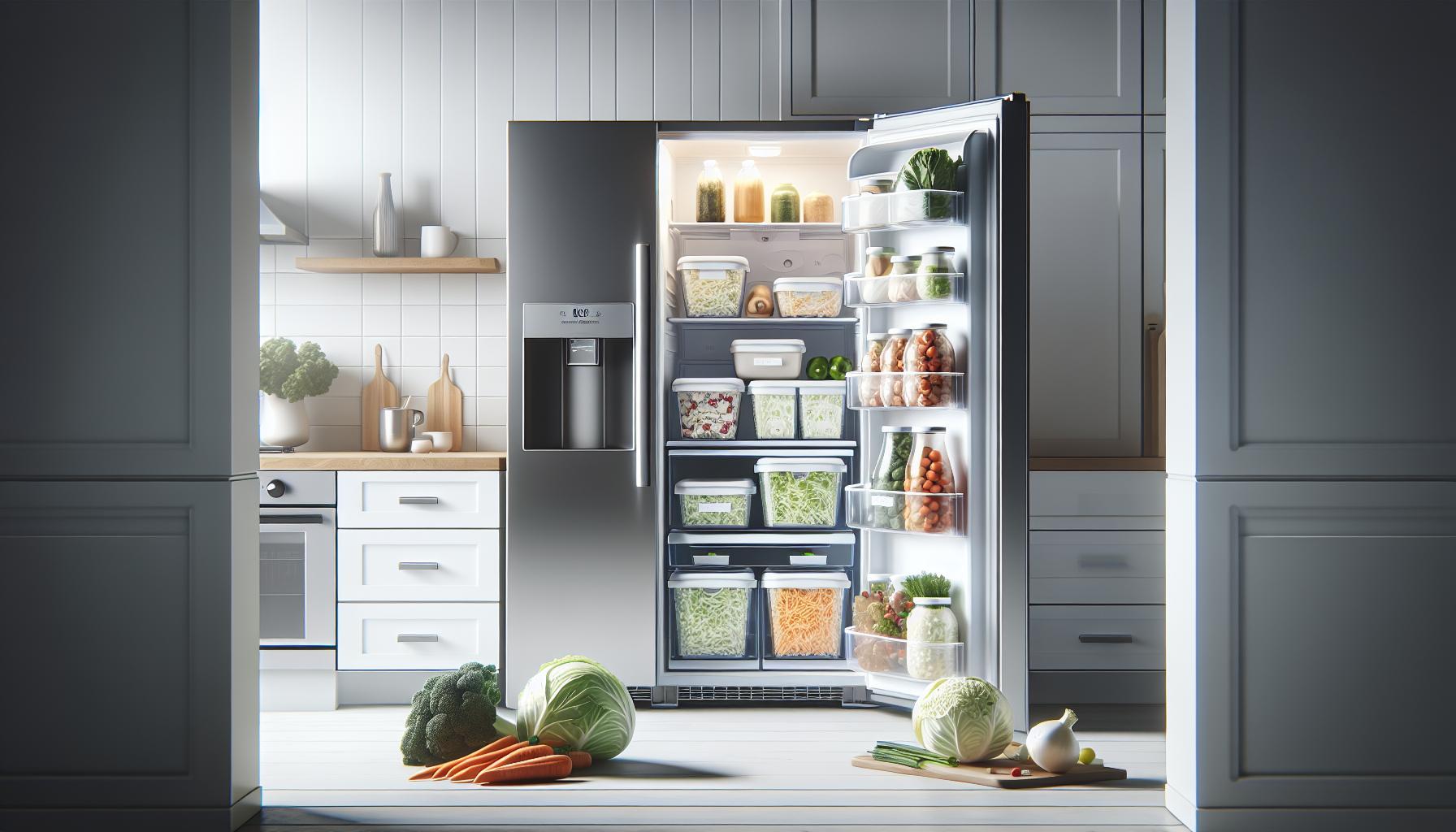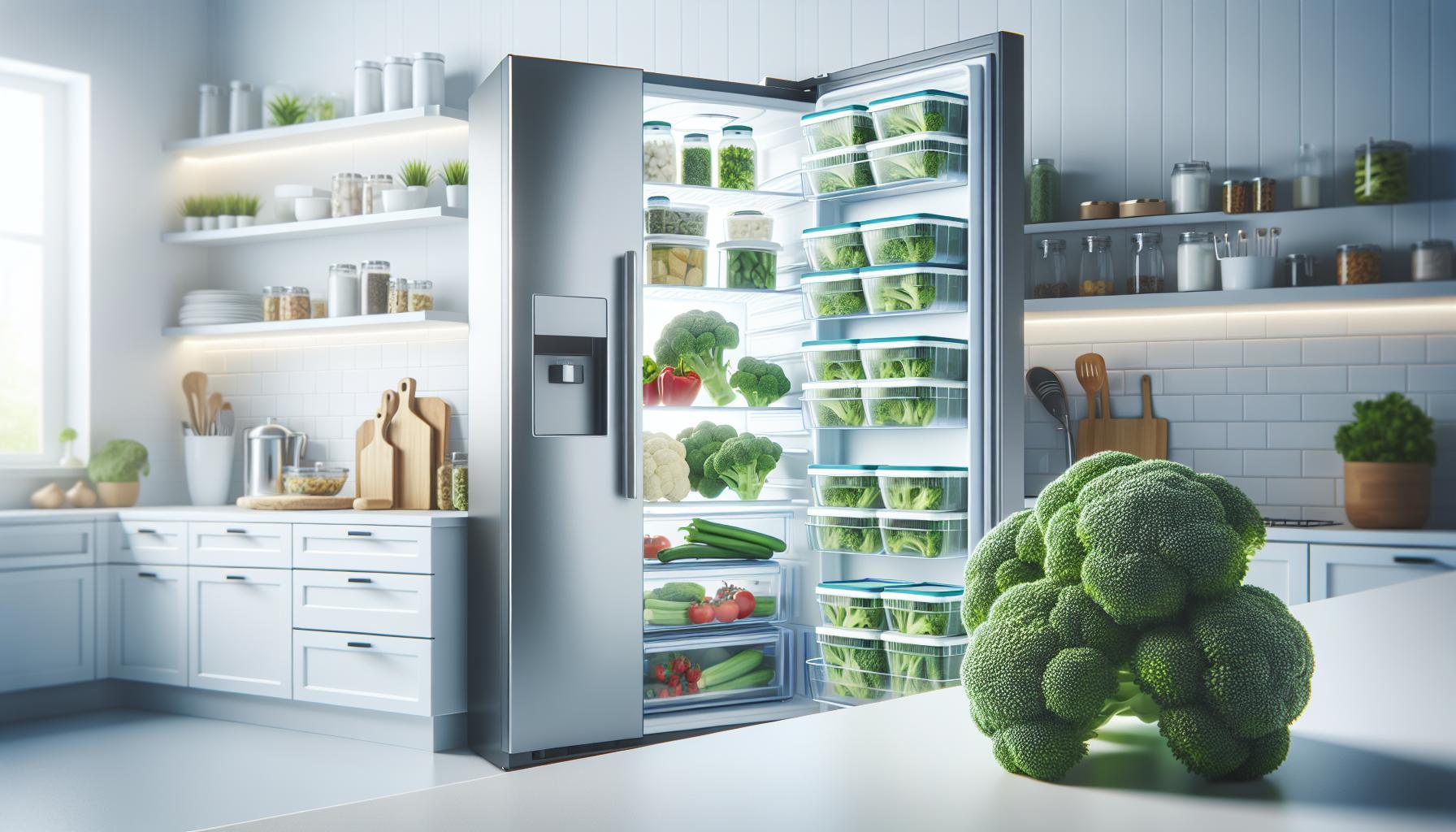Coleslaw is a beloved side dish that can enhance any meal, but how long can this creamy, crunchy delight last in your fridge? Understanding coleslaw’s shelf life is crucial not only for enjoying its peak freshness but also for ensuring food safety. With its mix of cabbage, carrots, and a zesty dressing, improper storage can lead to spoilage that you’ll want to avoid.
The good news is that with the right storage techniques, you can keep your coleslaw fresh and appetizing for a longer duration. Whether you’re preparing it for a picnic, potluck, or a family dinner, knowing how to store your coleslaw properly can help you minimize waste and maximize flavor. Dive into our guide as we reveal essential tips on freshness, safe storage practices, and signs of spoilage, empowering you to enjoy your coleslaw with confidence.
How Long Can You Keep Coleslaw in the Fridge?
Coleslaw can add a refreshing crunch to any meal, but understanding how long it stays fresh in the fridge is vital for both food safety and flavor. Generally, homemade coleslaw can be stored in the refrigerator for about 3 to 5 days. This timeframe ensures that the cabbage and other ingredients maintain their crisp texture and vibrant taste, avoiding unpleasant wilting or spoilage. For store-bought coleslaw, check the “use by” date on the packaging, as it may contain preservatives that can extend its shelf life beyond homemade versions.
Several factors affect coleslaw’s freshness, including the ingredients used and how it’s stored. If the coleslaw has dairy-based dressings, such as those made with sour cream or yogurt, it may spoil faster than versions dressed with vinegar or oil. To maximize freshness, it’s essential to store coleslaw in an airtight container. This practice helps prevent moisture loss and protects against exposure to air, which can lead to faster degradation of texture and flavor.
In addition to time and storage practices, paying attention to the coleslaw’s appearance and smell is crucial. If you notice any off odors, discoloration, or excessive liquid separation, these can indicate that the coleslaw has passed its prime. Keeping these guidelines in mind will help you enjoy your coleslaw safely and deliciously, making it a delightful addition to your meals without worry.
Factors Affecting Coleslaw Freshness
The freshness of coleslaw hinges on several key factors, each contributing to how long this delightful salad can safely be enjoyed. Primarily, the ingredients play a significant role; for instance, coleslaw made with creamy dressings, such as those containing sour cream or mayonnaise, tends to have a shorter shelf life than versions dressed with vinegar. Creamy dressings can lead to faster spoilage due to the dairy content, so it’s wise to consume these types within about 3 days after preparation.
Proper storage practices are equally critical. To enhance coleslaw’s longevity, it’s essential to keep it in an airtight container. This method minimizes exposure to air, which can accelerate oxidation and degradation of both texture and flavor. Additionally, it’s beneficial to store the coleslaw in the coldest part of the refrigerator, typically towards the back rather than the front, which can help maintain optimal temperatures even when the fridge door is opened frequently.
Environmental factors such as moisture and temperature fluctuations can also affect coleslaw’s freshness. When coleslaw is left out at room temperature, especially during hot months, bacteria can multiply rapidly, leading to spoilage in a matter of hours. Always ensure that any leftovers are promptly refrigerated after serving. Furthermore, keeping the coleslaw away from strong odors in the fridge is advisable, as cabbage is notorious for absorbing smells, which can alter its flavor and enjoyment.
Lastly, observing the coleslaw’s color, texture, and smell serves as an excellent indicator of its freshness. If you notice any excessive liquid pooling at the bottom of the container, a sour or off aroma, or a dull coloration, it’s a sign that the coleslaw is past its prime and should be discarded. By understanding these factors, you can better manage your coleslaw storage, maximizing its deliciousness and ensuring food safety.
Storing Coleslaw: Best Practices for Longevity
To keep coleslaw fresh and delicious for as long as possible, adhering to the right storage practices is crucial. Properly stored, coleslaw can last anywhere from three to five days in the refrigerator, but this time frame can vary depending on the ingredients used and the storage conditions. Here are some best practices to extend the life of your coleslaw.
First and foremost, choose an airtight container for storage. This minimizes air exposure, which can lead to oxidation and a decline in both flavor and texture. Glass containers with tight-fitting lids are excellent options, as they are less likely to retain odors and are easy to clean. As a rule of thumb, always refrigerate coleslaw promptly after serving to limit the growth of bacteria, especially after it has been at room temperature for more than two hours.
Another key factor to consider is the placement of the container in your refrigerator. Store the coleslaw towards the back of the fridge, where temperatures tend to be more stable and cooler. The front section or door is more susceptible to temperature fluctuations, especially when the fridge is opened frequently. Keeping it away from strong-smelling foods will also prevent the cabbage from absorbing any undesirable odors, maintaining its fresh taste.
To avoid premature spoilage, consider dressing your coleslaw just before serving if possible. This way, the salad’s components remain crispy and flavorful for a longer period. If you anticipate leftover coleslaw, try to save the dressing in a separate container. For instance, if you’re using a creamy dressing, feel free to pour it on only the portion you plan to serve, keeping the rest as fresh as possible for later use.
Remembering these practices can significantly enhance your coleslaw’s freshness, ensuring you can enjoy this crisp, tangy salad over several days without compromising its quality.
Signs Your Coleslaw Has Spoiled
Coleslaw is a popular side dish known for its crisp texture and fresh flavors, but it’s essential to recognize when it has gone bad. Spoilage can occur even under the best storage conditions, and consuming spoiled coleslaw can lead to foodborne illness. Knowing the visual and sensory indicators of spoilage can help you make better decisions at mealtime.
One of the first signs that coleslaw has spoiled is a change in color. Fresh coleslaw typically features vibrant greens from the cabbage and the bright orange of shredded carrots. Over time, a dull, yellowish hue or browning may develop due to oxidation and breakdown of the vegetables. In combination with discoloration, you should also check for any unpleasant odors. Fresh coleslaw carries a slightly sweet and tangy scent, while spoiled coleslaw may emit sour or rancid smells, indicating bacterial growth.
Texture is equally important in assessing spoilage. Fresh coleslaw is crunchy and crisp, while spoiled versions tend to become soggy or mushy. This texture change often occurs after the dressing has interacted with the vegetables for too long, leading to excess moisture. Additionally, if you notice the formation of any mold or slime on the surface, it’s a clear sign that the coleslaw should be discarded immediately, as these are indicators of bacterial contamination.
If you’re unsure about your coleslaw’s freshness but notice these telltale signs, it’s always safer to err on the side of caution. Discarding food that you suspect may be spoiled is a wise choice to avoid health risks associated with spoiled produce. By being vigilant and regularly checking your coleslaw before consumption, you can ensure that you enjoy this delicious dish safely.
How to Extend the Shelf Life of Coleslaw
To keep your coleslaw fresh for as long as possible, it’s crucial to implement effective storage strategies and understand some basic food safety practices. Coleslaw can typically last about 3 to 5 days in the fridge when stored correctly. However, several factors can influence its longevity, including the ingredients used, how it’s mixed, and how it’s stored.
One of the best ways to extend the shelf life of coleslaw is to store it in an airtight container. This prevents moisture from entering and slowing down the spoilage process. When preparing coleslaw, consider holding off on adding the dressing until you’re ready to serve. This not only maintains the texture of the veggies but also minimizes moisture, keeping the coleslaw crisp for longer. If making coleslaw in advance, consider mixing just the cabbage and other raw ingredients ahead of time and adding the dressing a few hours before consumption.
Another tip is to keep the coleslaw in the coldest part of the refrigerator, usually the back, rather than in the door where temperatures fluctuate more. Make sure that your fridge is set to 40°F (4°C) or lower. Also, regularly check the coleslaw for signs of spoilage, as sooner detection can prevent consumption of spoiled food.
For those who want to keep coleslaw fresh beyond a week, freezing is an option, although it may change the texture of the cabbage. If freezing is the right choice for you, consider blending the dressing separately and freezing the solids. When ready to serve, you can thaw and mix everything together. However, note that frozen coleslaw is best used in cooked dishes rather than served fresh.
In summary, by storing coleslaw properly and following these tips, you can enjoy its delicious, crisp taste safely and for a longer period, reducing food waste and making the most of your culinary creations!
Coleslaw Storage Containers: What Works Best?
Choosing the right storage container for your coleslaw is crucial for maintaining its freshness and texture. Using appropriate containers not only extends the life of your coleslaw, but also helps preserve the flavor and crispness of the vegetables. Here are some of the best options to consider when storing coleslaw.
Airtight Containers
The gold standard for coleslaw storage is an airtight container. These are designed to keep air and moisture out, which can help slow down the spoilage process. Look for containers made from food-grade plastic or glass, which are both durable and help seal in freshness. MASON jars are a fantastic choice, as they provide an airtight seal and are also visually appealing if you plan on serving from the same container.
Portion Control Containers
If you’re preparing coleslaw for a gathering or meal prep, consider using smaller, portion-controlled containers. This approach allows you to take out only what you need without exposing the rest of the coleslaw to air and potential contaminants. Smaller containers are particularly useful for individual servings or lunchboxes, keeping leftovers fresh longer.
Plastic Wrap & Foil
In a pinch, using plastic wrap or aluminum foil to cover your coleslaw can also work, but these methods offer less protection than airtight containers. If you choose this method, make sure to keep the wrap snug against the surface of the coleslaw to minimize air exposure. Keep in mind that using wrap will not preserve crispness as effectively as a proper container might, particularly for more extended storage times.
Cooler Locations
Regardless of the type of container you choose, always store your coleslaw in the coldest part of your refrigerator, ideally at the back or on the bottom shelf. This placement helps avoid temperature fluctuations that occur in the door or warmer areas.
By selecting the right storage containers and following these tips, you ensure that your coleslaw remains fresh, crisp, and ready to enjoy for up to 3 to 5 days. Adopting these strategies can help you make the most of your culinary creations while minimizing food waste.
Homemade vs. Store-Bought: Freshness Differences
When it comes to freshness, there’s a significant difference between homemade and store-bought coleslaw that can affect how long each type lasts in your fridge. Homemade coleslaw typically contains fresh ingredients, such as cabbage, carrots, and a dressing made from scratch. Since it lacks preservatives, it usually has a shorter shelf life and is best consumed within 3 to 5 days after preparation. This short timeframe is largely due to the absence of artificial additives that stabilize the product. To ensure you enjoy the best flavor and texture, it’s advisable to keep homemade coleslaw refrigerated in an airtight container.
In contrast, store-bought coleslaw often contains preservatives that help extend its freshness. Commercial brands may use various additives that can inhibit the growth of bacteria, allowing them to last up to a week or more, even when refrigerated. However, it’s crucial to check the expiration date on the packaging and observe how it looks and smells. Despite these preservatives, the quality may still diminish over time. The vinegar-based dressings commonly used in store-bought options can also help keep the vegetables crisp longer, although they may alter the flavor profile compared to freshly made versions.
When deciding between homemade and store-bought coleslaw, consider not only freshness but also the intended use. If you’re preparing coleslaw for a special event, homemade versions can offer vibrant flavors tailored to your taste. Conversely, if you require a quick side dish with an extended shelf life, opting for store-bought might be the practical choice. Regardless of your decision, storing either type properly in cool temperatures will help maximize their longevity. Always ensure both types of coleslaw are kept in airtight containers to maintain freshness and prevent spoilage.
How to Safely Reheat Leftover Coleslaw
Reheating leftover coleslaw requires careful consideration, not just for flavor but also for food safety. While coleslaw is often enjoyed cold, there may be occasions when you want to warm it up, especially if it accompanies a hot dish. However, unlike many cooked dishes, coleslaw contains delicate fresh vegetables that can lose their crisp texture and reproducible flavor when exposed to heat. Therefore, it’s generally advisable to avoid reheating coleslaw.
If you decide to proceed and warm coleslaw, the best method is to use gentle heat. Microwave ovens can be very effective-start by placing a small portion in a microwave-safe dish and cover it with a lid or microwave-safe wrap to maintain moisture. Heat it in short intervals of 15 to 20 seconds, stirring in between, until it’s just warm. Avoid overheating, as high temperatures can make the cabbage soggy and diminish the overall quality.
For a more culinary-forward option, consider briefly sautéing the coleslaw in a skillet over low heat. Add a splash of vinegar or a touch of oil to enhance flavors and prevent sticking, stirring frequently. This method can introduce a caramelized note and slightly change the texture while still preserving some of the coleslaw’s fresh qualities. However, remember that reheating and cooking can lead to a significant change in texture and taste. Always taste as you reheat to achieve the desired warmth and flavor.
In terms of food safety, ensure that any leftover coleslaw has been stored correctly-refrigerated in an airtight container and consumed within the 3 to 5-day window for homemade versions or according to the expiration date for store-bought options. If the coleslaw shows any signs of spoilage or has been left out at room temperature for more than two hours, it’s best to discard it to avoid any health risks.
Coleslaw Freezing: Is It Possible?
Freezing coleslaw is often a point of confusion for home cooks. While the idea of preserving this classic side dish for future meals might be appealing, the reality is a bit more complex. Coleslaw is primarily composed of fresh vegetables like cabbage and carrots, which have high water content. When frozen, these vegetables can lose their crispness and texture, leading to a mushy end product when thawed.
If you find yourself with an abundance of coleslaw and wish to freeze it, it’s important to approach the process carefully. Consider the type of coleslaw-those made with vinegar-based dressings can freeze better than creamy mayonnaise-based versions, which tend to separate and become unappetizing. To freeze coleslaw, start by portioning it into airtight freezer bags or containers, removing as much air as possible to prevent freezer burn. Label the containers with the date of freezing to keep track of freshness.
To ensure quality, it’s advisable to consume frozen coleslaw within two to three months. When you’re ready to use it, thaw the coleslaw in the refrigerator overnight rather than at room temperature to maintain food safety. Keep in mind that once thawed, the texture may still be compromised, making it more suitable for cooking applications-such as including it in stir-fries or casseroles-rather than serving it fresh.
Remember, while freezing coleslaw can extend its shelf life, the best way to preserve its flavor and texture is to enjoy it fresh. For optimal enjoyment, consider making smaller batches that can be consumed within a few days, allowing the crunchy texture and vibrant taste to shine through.
Delicious Ways to Use Leftover Coleslaw
Using up leftover coleslaw can be a delicious way to minimize waste and add flavor to your meals. Not only does coleslaw provide a crunchy texture, but its tangy dressing can enhance various dishes. If you have some coleslaw sitting in your fridge, here are several creative and tasty ideas to help clear it out while enjoying every bite.
One of the easiest ways to repurpose coleslaw is to use it as a topping for sandwiches and burgers. A scoop of coleslaw can add a refreshing crunch to pulled pork sandwiches, chicken sandwiches, or even veggie burgers. It pairs beautifully with barbecue sauce and can transform a simple dish into a flavorful experience.
Coleslaw can also be integrated into salads to bulk up nutritional value and texture. Mix leftover coleslaw into grain salads, such as quinoa or couscous, for added fiber and flavor. Another option is to toss it with leafy greens, nuts, and a light vinaigrette for a quick and satisfying side salad. The crunch from the vegetables combined with the leafy greens creates a delightful contrast.
For a fusion twist, consider using coleslaw as a filling for wraps or tacos. Spread some coleslaw in a tortilla, add protein such as grilled chicken, tofu, or beans, and roll it up for a quick meal. You can also use it as a topping for fish or shrimp tacos for an extra layer of flavor.
If you’ve got more substantial portions of coleslaw, you could incorporate it into stir-fries or casseroles. Adding coleslaw to a stir-fry allows the vegetables to cook briefly while still retaining some crunch, and it contributes a unique flavor profile. It’s also a fun addition to pasta dishes-just fold it in right at the finish for a creamy texture without the need for heavy dressings.
Finding creative ways to use leftover coleslaw not only enhances your meals but also promotes sustainability in your kitchen. With these ideas, you can maximize the enjoyment of coleslaw while keeping your meals varied and exciting.
Common Mistakes to Avoid When Storing Coleslaw
Storing coleslaw correctly requires more than just tossing it in the fridge; there are common pitfalls that can lead to compromised freshness and flavor. One frequent mistake is not using an airtight container. Exposure to air can cause the cabbage to wilt and the dressing to separate, resulting in a less appealing texture and taste. Opt for high-quality, airtight containers to minimize oxidation and moisture loss.
Another common error is failing to keep coleslaw separate from dressings until serving. If the coleslaw is dressed too far in advance, it can become soggy, losing its delightful crunch. For optimal taste and texture, consider storing the shredded cabbage and the dressing separately and combine them just before serving. This approach not only preserves freshness but also allows for more versatile use of leftovers.
Temperature can also play a crucial role in coleslaw storage. Many people mistakenly leave coleslaw out for extended periods during gatherings or parties. Coleslaw should never be left at room temperature for more than two hours; doing so can lead to bacterial growth and spoilage. Always refrigerate promptly, and ensure that your fridge maintains a consistent temperature of 40°F (4°C) or below.
Finally, keep an eye on the expiration date of any store-bought ingredients. Pre-packaged coleslaw mixes or dressings can come with a sell-by date and, if used past that date, may contribute to spoilage even if the coleslaw itself appears fine. Regularly check your ingredients and discard any that are past their prime to maintain the safety and quality of your dishes. Being mindful of these common mistakes can significantly extend the life of your coleslaw, ensuring it remains a delicious accompaniment to your meals.
Frequently Asked Questions
Q: How can you tell if coleslaw is still good to eat?
A: To determine if coleslaw is still fresh, check for off smells, discoloration, or a slimy texture. If it smells sour or looks excessively wilted, discard it. Always trust your senses; when in doubt, throw it out.
Q: Can you freeze coleslaw, and how should it be done?
A: Yes, coleslaw can be frozen. However, keep in mind that the texture may change once thawed. To freeze, place the coleslaw in an airtight container, removing as much air as possible. It can last up to 3 months in the freezer.
Q: How should you store coleslaw to extend its freshness?
A: Store coleslaw in an airtight container in the refrigerator. For added freshness, keep the dressing separate until you’re ready to serve. This helps maintain the crispness of the cabbage and other vegetables.
Q: What are the best types of containers for storing coleslaw?
A: Glass or BPA-free plastic containers with airtight seals work best for storing coleslaw as they reduce exposure to air and light. Opt for containers that are slightly larger than the coleslaw to minimize air space.
Q: How long can homemade coleslaw last in the fridge?
A: Homemade coleslaw typically lasts about 3 to 5 days in the refrigerator if stored properly in an airtight container. Be sure to monitor for any signs of spoilage.
Q: What ingredients in coleslaw can affect its shelf life?
A: Ingredients like mayonnaise can shorten coleslaw’s shelf life due to their perishable nature. Vinegar-based dressings tend to keep coleslaw fresher for longer, making them preferable for extended storage.
Q: Can you use leftover coleslaw in other recipes?
A: Absolutely! Leftover coleslaw can be used in sandwiches, tacos, or as a topping for burgers. It also makes a great addition to salads and wraps, adding flavor and crunch.
Q: Should coleslaw be served cold or at room temperature?
A: Coleslaw is best served cold to enhance its refreshing crunch. Refrigerate at least 30 minutes before serving to allow flavors to meld and to maintain a cool, crisp texture.
To Conclude
When it comes to enjoying coleslaw at its best, knowing how long it lasts in the fridge is crucial for maintaining freshness and flavor. Remember, properly stored coleslaw should stay tasty for about 3 to 5 days. If you’re unsure about its quality, always trust your senses-look for off odors or discoloration before indulging. For more tips on keeping your salads fresh, check out our guides on Storing Vegetables for Maximum Freshness and Preventing Food Waste with Smart Storage.
Ready to take your dishes to the next level? Explore our collection of delicious coleslaw recipes, like our creamy coleslaw or the tangy version for a refreshing twist at your next gathering. Don’t forget to subscribe to our newsletter for more expert tips and recipes, ensuring you never miss a beat in the kitchen! Your feedback is valuable to us-share your thoughts or ask questions in the comments below and join our vibrant cooking community today!





